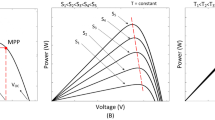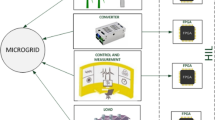Abstract
To extract the maximum power from a photovoltaic (PV) energy system, the real-time maximum power point (MPP) of the PV array must be tracked closely. The non-linear and time-variant characteristics of the PV array and the non-linear and non-minimum phase characteristics of a boost converter make it difficult to track the MPP for traditional control strategies. We propose a fuzzy neural network controller (FNNC), which combines the reasoning capability of fuzzy logical systems and the learning capability of neural networks, to track the MPP. With a derived learning algorithm, the parameters of the FNNC are updated adaptively. A gradient estimator based on a radial basis function neural network is developed to provide the reference information to the FNNC. Simulation results show that the proposed control algorithm provides much better tracking performance compared with the fuzzy logic control algorithm.
Similar content being viewed by others
References
Altas, I.H., Sharaf, A.M., 2008. A novel maximum power fuzzy logic controller for photovoltaic solar energy systems. Renewable Energy, 33(3):388–399. [doi:10.1016/j.renene.2007.03.002]
Brambilla, A., 1999. New Approach to Photovoltaic Arrays Maximum Power Point Tracking. 30th Annual IEEE Power Electronics Specialists Conf., South Carolina, USA, p.632–637.
Das, D., Esmaili, R., Xu, L., Nichols, D., 2005. An Optimal Design of a Grid Connected Hybrid Wind/Photovoltaic/Fuel Cell System for Distributed Energy Production. 32nd Annual Conf. of the IEEE Industrial Electronics Society, Paris, France, p.2499–2504.
Hiyama, T., Kouzuma, S., Imakubo, T., Ortmeyer, T.H., 1995. Evaluation of neural network based real time maximum power tracking controller for PV system. IEEE Trans. Energy Conv., 10(3):543–548. [doi:10.1109/60.464880]
Huang, S.J., Huang, K.S., Chiou, K.C., 2003. Development and application of a novel radial basis function sliding mode controller. Mechatronics, 13(4):313–329. [doi:10. 1016/S0957-4158(01)00050-2]
Kazimierczuk, M.K., Starman, L.A., 1999. Dynamic performance of PWM DC-DC boost converter with input voltage feedforward control. IEEE Trans. Circuits Syst. I: Fundam. Theory Appl., 46(12):1473–1481. [doi:10.1109/81.809549]
Lee, C.H., Teng, C.C., 2000. Identification and control of dynamic systems using recurrent fuzzy neural networks. IEEE Trans. Fuzzy Syst., 8(4):349–366. [doi:10.1109/91.868943]
Lin, F.J., Lin, C.H., 2004. A permanent-magnet synchronous motor servo drive using self-constructing fuzzy neural network controller. IEEE Trans. Energy Conv., 19(1):66–72. [doi:10.1109/TEC.2003.821835]
Lin, F.J., Wai, R.J., 2002. Adaptive fuzzy-neural-network control for induction spindle motor drive. IEEE Tran. Energy Conv., 17(4):507–513. [doi:10.1109/TEC.2002.805225]
Mukerjee, A.K., Dasgupta, N., 2007. DC power supply used as photovoltaic simulator for testing MPPT algorithms. Renewable Energy, 32(4):587–592. [doi:10.1016/j.renene.2006.02.010]
Patcharaprakiti, N., Premrudeepreechacharn, S., Sriuthaisiriwong, Y., 2005. Maximum power point tracking using adaptive fuzzy logic control for grid-connected photovoltaic system. Renewable Energy, 30(11):1771–1788. [doi:10.1016/j.renene.2004.11.018]
Santos, J.L., Antunes, F., Chehab, A., Cruz, C., 2006. A maximum power point tracker for PV systems using a high performance boost converter. Solar Energy, 80(7):772–778. [doi:10.1016/j.solener.2005.06.014]
Shtessel, Y.B., Zinober, A.S.I., Shkolnikov, I.A., 2003. Sliding mode control of boost and buck-boost power converters using method of stable system centre. Automatica, 39(6):1061–1067. [doi:10.1016/S0005-1098(03)00068-2]
Swiegers, W., Enslin, J.H.R., 1998. An Integrated Maximum Power Point Tracker for Photovoltaic Panels. Proc. IEEE Int. Symp. on Industrial Electronics, Pretoria, South Africa, p.40–44.
Torres, A.M., Antunes, F.L.M., 1998. An Artificial Neural Network-based Real Time Maximum Power Tracking Controller for Connecting a PV System to the Grid. 24th Annual Conf. of the IEEE Industrial Electronics Society, Aachen, Germany, p.554–558.
Valenciaga, F., Puleston, P.F., Battaiotto, P.E., 2001. Power control of a photovoltaic array in a hybrid electric generation system using sliding mode techniques. IEE Proc.- Control Theory Appl., 148(6):448–455. [doi:10.1049/ip-cta:20010785]
Xiao, W., Dunford, W.G., Capel, A., 2004. A Novel Modeling Method for Photovoltaic Cells. IEEE Power Electronics Specialists Conf., Aachen, Germany, p.1950–1956.
Xiao, W., Dunford, W.G., Palmer, P.R., Capel, A., 2007a. Regulation of photovoltaic voltage. IEEE Trans. Ind. Electron., 54(3):1365–1374. [doi:10.1109/TIE.2007.893059]
Xiao, W., Ozog, N., Dunford, W.G., 2007b. Topology study of photovoltaic interface for maximum power point tracking. IEEE Trans. Ind. Electron., 54(3):1696–1704. [doi:10. 1109/TIE.2007.894732]
Zhong, Z.D., Huo, H.B., Zhu, X.J., 2008. Adaptive maximum power point tracking control of fuel cell power plants. J. Power Sources, 176:259–269. [doi:10.1016/j.jpowsour.2007.10.080]
Author information
Authors and Affiliations
Corresponding author
Additional information
Project (No. 20576071) supported by the National Natural Science Foundation of China
Rights and permissions
About this article
Cite this article
Li, Ch., Zhu, Xj., Cao, Gy. et al. A maximum power point tracker for photovoltaic energy systems based on fuzzy neural networks. J. Zhejiang Univ. Sci. A 10, 263–270 (2009). https://doi.org/10.1631/jzus.A0820128
Received:
Accepted:
Published:
Issue Date:
DOI: https://doi.org/10.1631/jzus.A0820128
Key words
- Photovoltaic array
- Maximum power point tracking (MPPT)
- Fuzzy neural network controller (FNNC)
- Radial basis function neural network (RBFNN)




